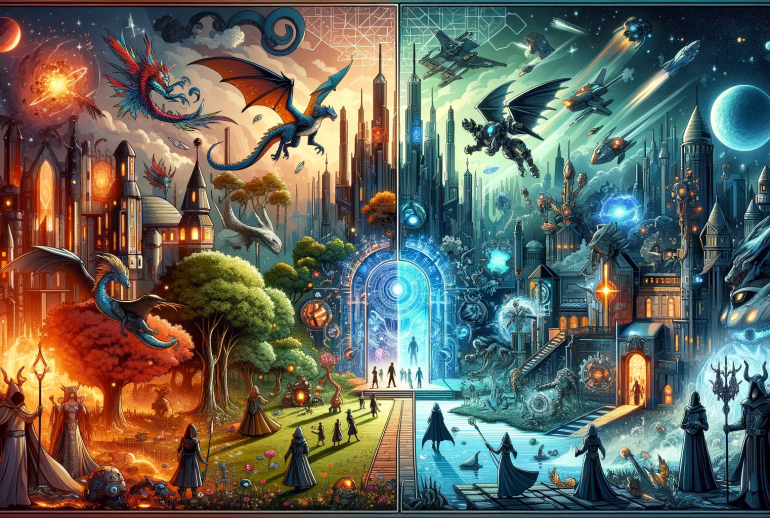In the realm of storytelling, the power to create entire worlds rests in the hands of authors. These worlds serve as the backdrop for narratives, offering readers a space to explore, imagine, and immerse themselves. However, in the digital age, the boundaries of storytelling are expanding, and readers crave more than passive engagement. They yearn for the opportunity to actively participate in the worlds they love. This desire has given rise to interactive world-building—a dynamic approach that invites readers to become co-creators and explorers of fictional realms. In this exploration, we venture into the realm of interactive world-building, uncovering the strategies and techniques that empower authors to engage readers in a collaborative journey through their fictional universes.
The Evolution of Storytelling
Traditional storytelling is a linear experience. Readers embark on a predetermined path, following the author’s narrative choices. While this approach has its merits, it limits reader agency and interactivity. In contrast, interactive world-building transforms storytelling into a two-way street.
What is Interactive World-Building?
Interactive world-building allows readers to actively engage with and influence the fictional world and narrative. It blurs the lines between authorship and readership, inviting readers to participate in shaping the story’s direction, characters, and outcomes.
Creating an Interactive Narrative
Open-Ended Storytelling: Develop a narrative structure that allows for open-ended exploration. Instead of a single linear path, offer multiple branching storylines or a sandbox world where readers can make choices.
Character Collaboration: Allow readers to co-create characters, from their appearances to their backstories. This collaborative approach fosters a deeper connection between readers and the story.
Choice-Based Narratives: Implement decision points within the story where readers must make choices that affect the plot. These choices can range from small decisions to major turning points.
Feedback Loops: Create feedback mechanisms that respond to reader choices. The consequences of these choices should be felt within the narrative, reinforcing the idea that readers’ actions matter.
Case Study: “Choose Your Own Adventure” Series
The “Choose Your Own Adventure” series, pioneered by Edward Packard and R.A. Montgomery, epitomizes interactive world-building. These books present readers with choices at key moments, leading to different story outcomes. Readers actively shape the narrative by selecting their desired paths, creating a personalized reading experience.
Maintaining Narrative Coherence
While interactivity is paramount in interactive world-building, maintaining narrative coherence is equally essential:
World-Building Consistency: Ensure that the rules, physics, and logic of your fictional world remain consistent. Deviations should be purposeful and explained within the narrative.
Character Development: Character motivations and actions should align with the choices readers make. Characters should react believably to reader-driven decisions.
Feedback Integration: Construct a feedback system that seamlessly integrates the consequences of reader choices into the narrative. Readers should see the impact of their decisions.
Pacing and Flow: Craft a narrative that accommodates various paths and choices without disrupting pacing or causing confusion.
Engaging Readers on Multiple Levels
Interactive world-building offers various avenues for engaging readers:
Emotional Investment: By allowing readers to influence character relationships and outcomes, you foster emotional investment in the story.
Intellectual Engagement: Decision-making and exploration stimulate readers’ intellectual curiosity, encouraging critical thinking.
Sense of Ownership: Readers feel a sense of ownership over their chosen paths, making the story a more personal and memorable experience.
Community Building: Interactive narratives often lead to reader communities where enthusiasts discuss their experiences and share insights.
Challenges and Rewards
Interactive world-building presents both challenges and rewards:
Challenges:
Complexity: Creating an interactive narrative requires meticulous planning to ensure coherence, which can be time-consuming.
Variable Endings: Managing multiple story branches can be challenging, as each requires a satisfying and cohesive conclusion.
Rewards:
Reader Engagement: Interactive narratives foster a deeper connection with readers, leading to increased engagement and satisfaction.
Replayability: The branching nature of interactive narratives encourages readers to revisit the story to explore different paths.
Conclusion
Interactive world-building is a transformative approach to storytelling, offering readers agency and a sense of ownership within fictional universes. Authors who embrace this dynamic approach can create narratives that resonate deeply with readers, providing them with an immersive and personalized experience. While challenges exist in maintaining narrative coherence, the rewards—such as increased reader engagement and a thriving community of enthusiasts—are worth the effort. As interactive world-building continues to evolve, it opens new horizons for the art of storytelling, inviting readers to step into the role of co-creators and explorers of the vast, imaginative landscapes of fiction.



